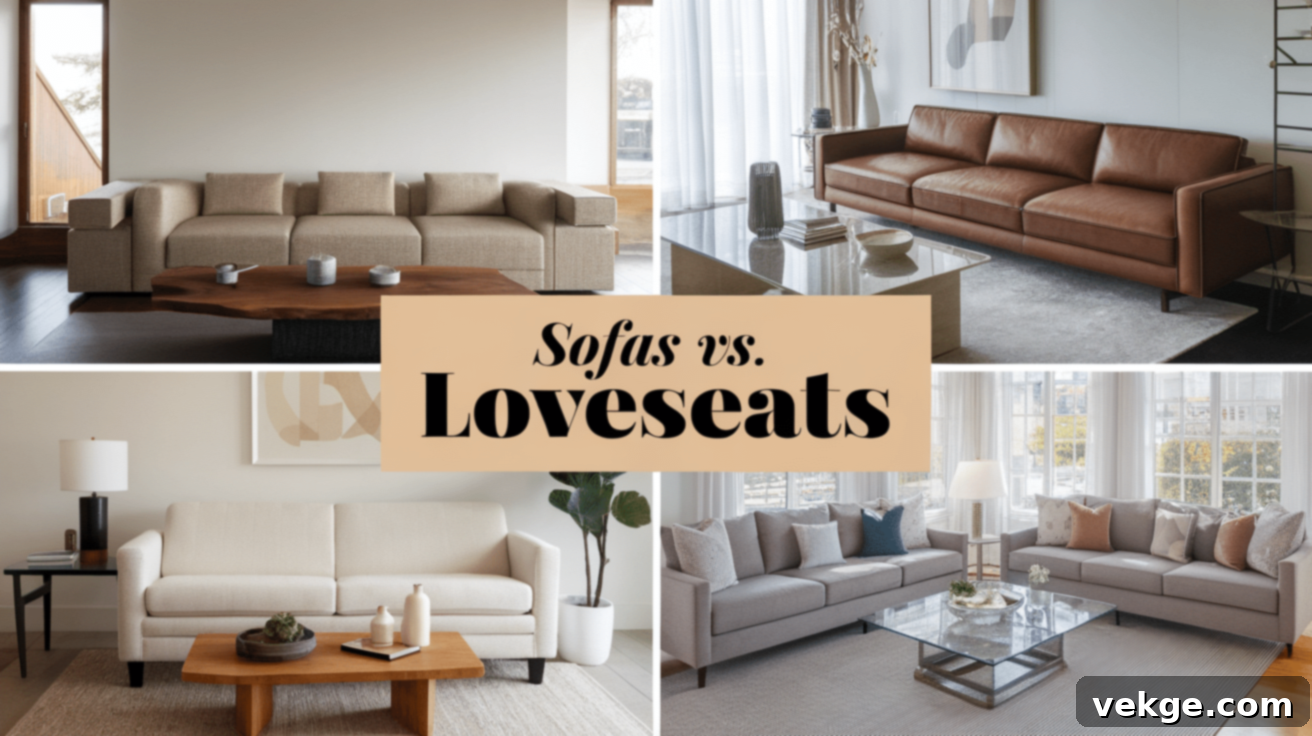Sofa vs. Loveseat: The Ultimate Guide to Choosing Your Perfect Living Room Seating
When furnishing your home, especially the living room, two of the most popular seating options you’ll encounter are sofas and loveseats. While both serve the fundamental purpose of providing comfortable seating, they possess distinct characteristics that cater to different needs, room sizes, and personal preferences. Understanding these differences is crucial for making an informed decision that enhances both the functionality and aesthetics of your living space.
A sofa, often recognized as the cornerstone of many living rooms, offers generous seating for multiple people, making it ideal for families or entertaining guests. In contrast, a loveseat is a more compact, intimate piece of furniture designed to comfortably accommodate two individuals. The choice between these two staple furniture pieces hinges on several factors, including the dimensions of your room, the number of people you typically need to seat, your desired level of comfort, and your overall interior design vision.
This comprehensive guide will delve into the specific attributes of sofas and loveseats, highlighting their key distinctions. We’ll explore their typical uses, design variations, and practical considerations like space requirements and budget. By the end of this article, you’ll have a clear understanding of which seating option, or perhaps a combination of both, is the perfect fit to create the inviting and functional home you envision. Let’s explore!
Understanding the Sofa: Your Go-To for Spacious Comfort
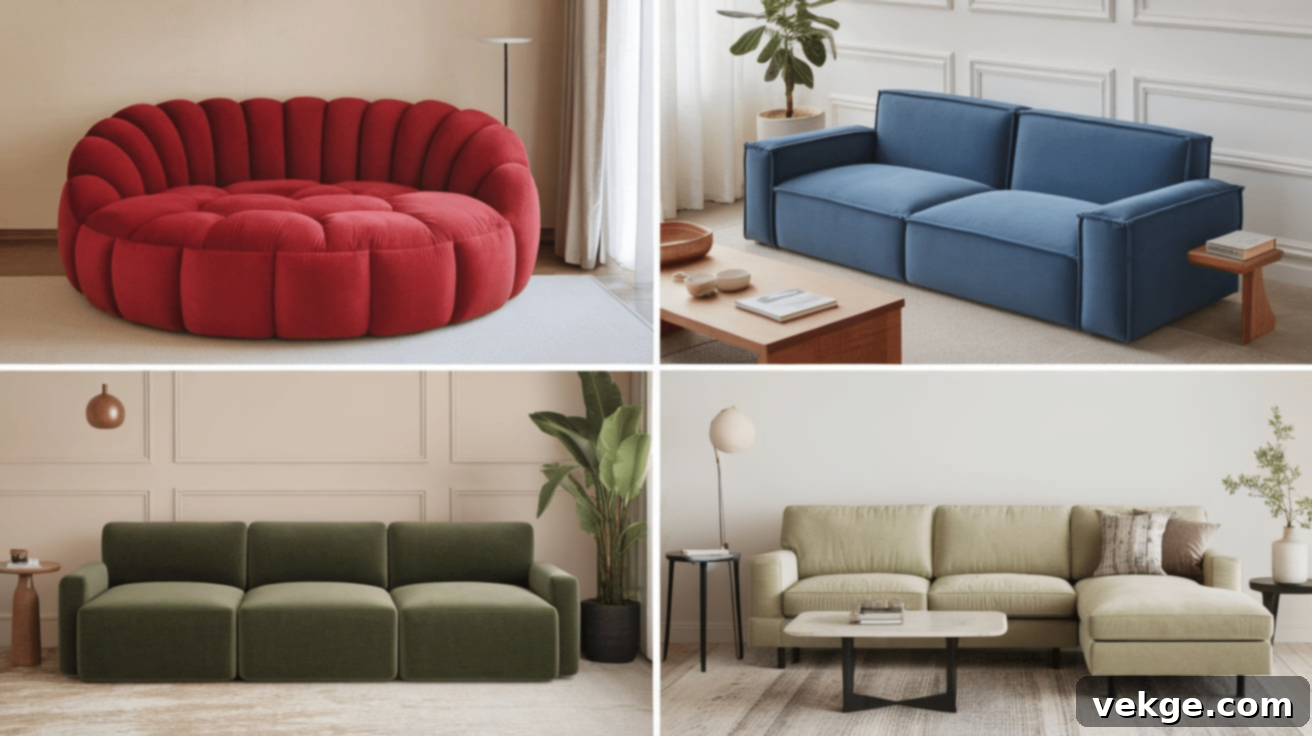
A sofa, also commonly referred to as a couch, is a substantial piece of upholstered furniture primarily designed for multiple people to sit comfortably. It is generally larger than a loveseat, offering more expansive seating and lounging opportunities. Depending on its specific design and dimensions, a standard sofa can typically accommodate anywhere from three to five individuals, making it a central hub for social gatherings, family movie nights, or simply sprawling out for a relaxing evening.
Sofas are celebrated for their incredible versatility in style, color, and material, allowing them to seamlessly integrate into virtually any home decor scheme. Whether you prefer a sleek modern design, a cozy traditional look, or a practical sectional, there’s a sofa tailored to every aesthetic and comfort requirement. Common materials range from luxurious leather and soft velvet to durable linen and practical microfiber, each offering a unique tactile experience and visual appeal.
Beyond providing ample seating, sofas often become the focal point of living rooms, family rooms, or larger open-plan spaces. They frequently feature deep cushions, supportive armrests, and robust frames engineered for long-lasting comfort and durability. This makes them perfect for various activities, from unwinding after a long day to hosting guests, reading a book, or enjoying quality time with loved ones. Their size ensures everyone has space to feel at ease, making them an indispensable element in homes that prioritize communal comfort and style.
Unveiling the Loveseat: Compact Charm for Intimate Settings
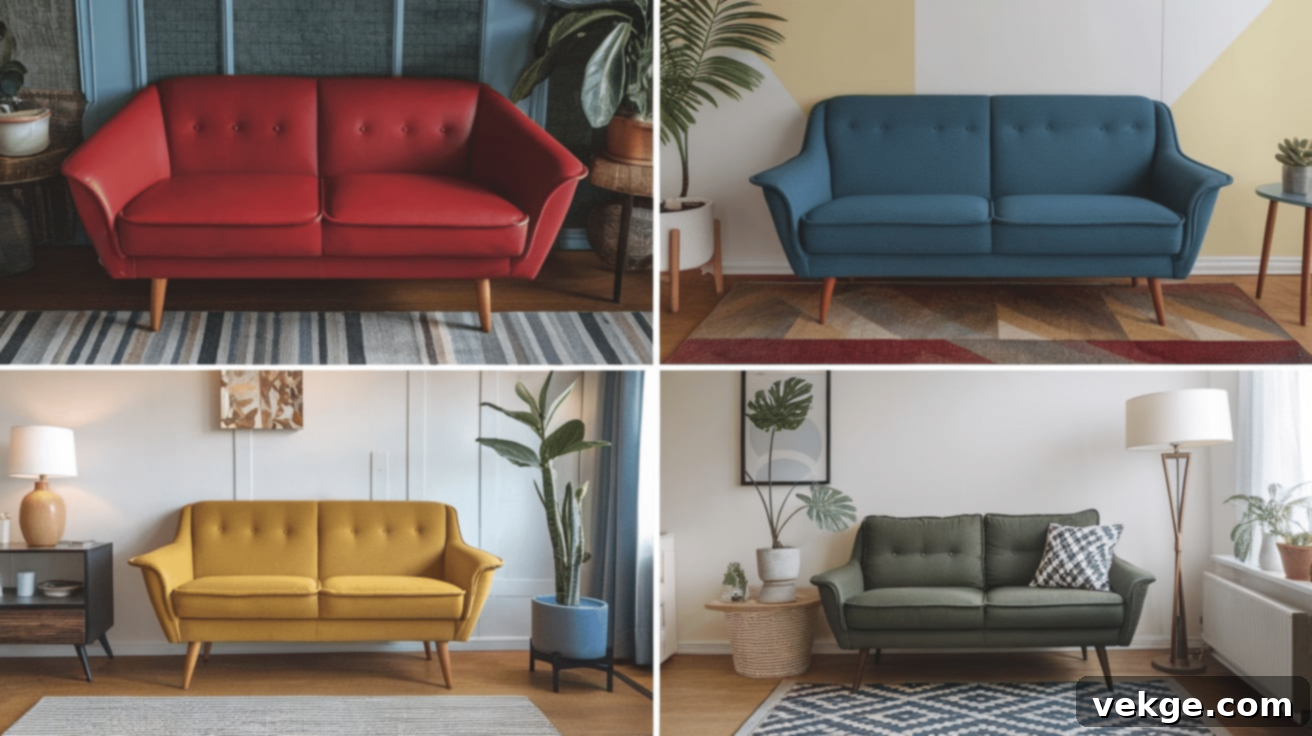
A loveseat is a smaller, more compact version of a sofa, specifically designed to comfortably seat two people. The name itself hints at its intended use – providing an intimate seating arrangement for a couple or two close friends. Despite its smaller footprint, a loveseat doesn’t compromise on style or comfort, making it an incredibly versatile piece of furniture for various spaces within your home.
Loveseats are an excellent choice for optimizing space in smaller living rooms, apartments, studios, or even bedrooms where a full-sized sofa might overwhelm the area. They can also serve as valuable accent pieces or supplementary seating in larger rooms, complementing a sofa or other chairs to create a more dynamic and functional layout. Their compact nature allows for greater flexibility in furniture arrangement, making it easier to create cozy nooks or define distinct zones within an open-concept space.
Just like their larger counterparts, loveseats are available in an extensive array of styles, colors, and materials. This ensures that you can find a loveseat that perfectly matches your existing decor or helps establish a new aesthetic direction. Whether you envision a chic contemporary design, a charming vintage piece, or a practical reclining model, loveseats offer abundant options. They are ideal for shared moments, quiet contemplation, or simply adding a touch of cozy elegance without consuming excessive floor space. Their ability to deliver comfort and style in a smaller package makes them a highly popular and practical choice for modern living.
Sofa vs. Loveseat: A Detailed Comparison of Key Differences
While both sofas and loveseats provide essential seating, their fundamental differences dictate their optimal use and suitability for various spaces. Understanding these distinctions is key to making the best choice for your home.
1. Size and Footprint
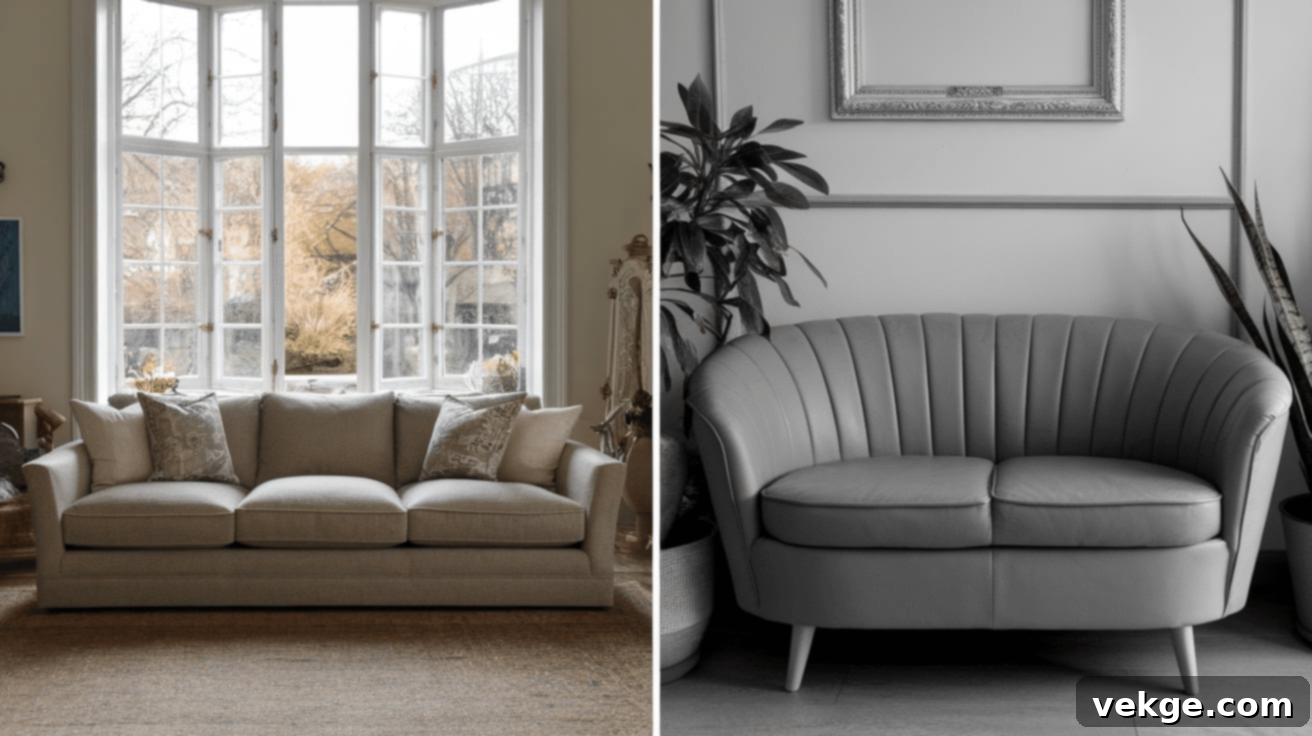
- Sofa: Sofas are significantly larger, typically ranging from 70 to 100 inches (1.78 to 2.54 meters) in length. This substantial size requires more floor space, making them best suited for spacious living rooms, family rooms, or open-plan areas where they can be accommodated comfortably without making the room feel cramped or hindering traffic flow. Their generous dimensions allow for ample room to spread out.
- Loveseat: Loveseats are much more compact, usually measuring between 50 to 70 inches (1.27 to 1.78 meters) in length. This smaller footprint makes them perfect for optimizing space in tighter areas such as small apartments, studios, hallways, or even as supplemental seating in larger rooms where every inch counts. They offer a neat and tidy seating solution without dominating the visual space.
2. Seating Capacity

- Sofa: Designed with larger groups in mind, sofas are built to comfortably seat three to five or even more people, depending on their length and style (e.g., a sectional sofa). This makes them ideal for households with multiple family members, those who frequently entertain guests, or anyone who desires abundant space for multiple individuals to gather and interact in comfort.
- Loveseat: True to its name, a loveseat is specifically designed for two people. It provides a cozy and intimate seating arrangement, perfect for couples, close friends, or for creating a snug spot for individual relaxation. While it doesn’t offer the capacity for large gatherings, its intimate scale encourages closer interaction and a sense of warmth.
3. Space Requirements and Room Fit

- Sofa: Due to their considerable size, sofas require a larger room or a dedicated wall space to fit harmoniously. Careful planning is needed to ensure that a sofa doesn’t obstruct walkways or overpower the room’s proportions. They often serve as the main anchor of a living area, dictating the layout of other furniture pieces around them.
- Loveseat: Loveseats excel in versatility for various room sizes and layouts. Their compact nature makes them suitable for smaller apartments, dens, or even as an addition to a larger living room where extra seating is desired without consuming too much space. They can easily fit into nooks, under windows, or complement a larger sofa without making the area feel cluttered.
4. Comfort and Lounging Potential
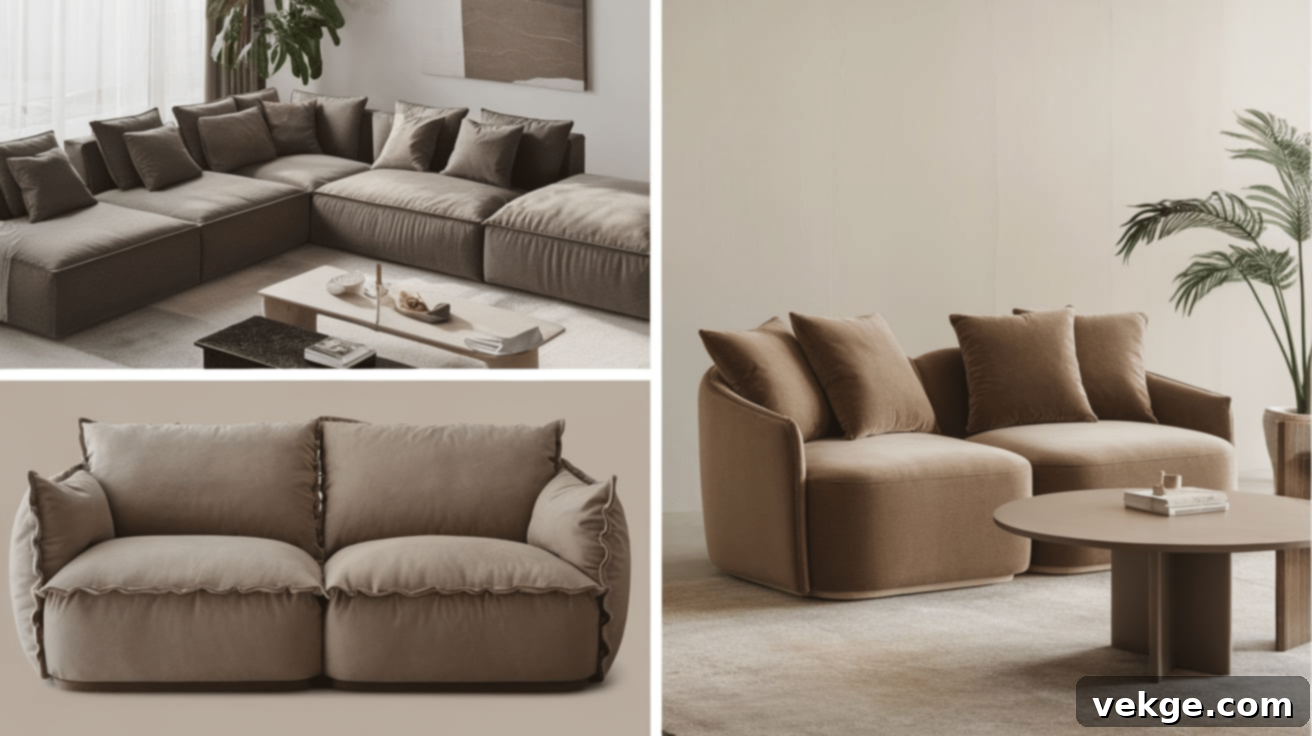
- Sofa: Sofas offer unparalleled potential for relaxation and extended lounging. Their ample length and depth provide enough space for individuals to stretch out, recline, or even take a nap. With bigger cushions and a more expansive surface area, sofas are typically more conducive to prolonged periods of comfort, making them a favorite for movie marathons or simply unwinding after a long day.
- Loveseat: While undeniably comfortable, loveseats are designed for more upright or closer sitting. They are excellent for intimate conversations or reading, but their shorter length limits the ability to fully stretch out or recline. They offer cozy comfort for two, but if expansive lounging is a priority, a sofa will generally provide a more satisfying experience.
5. Style, Design, and Aesthetic Impact
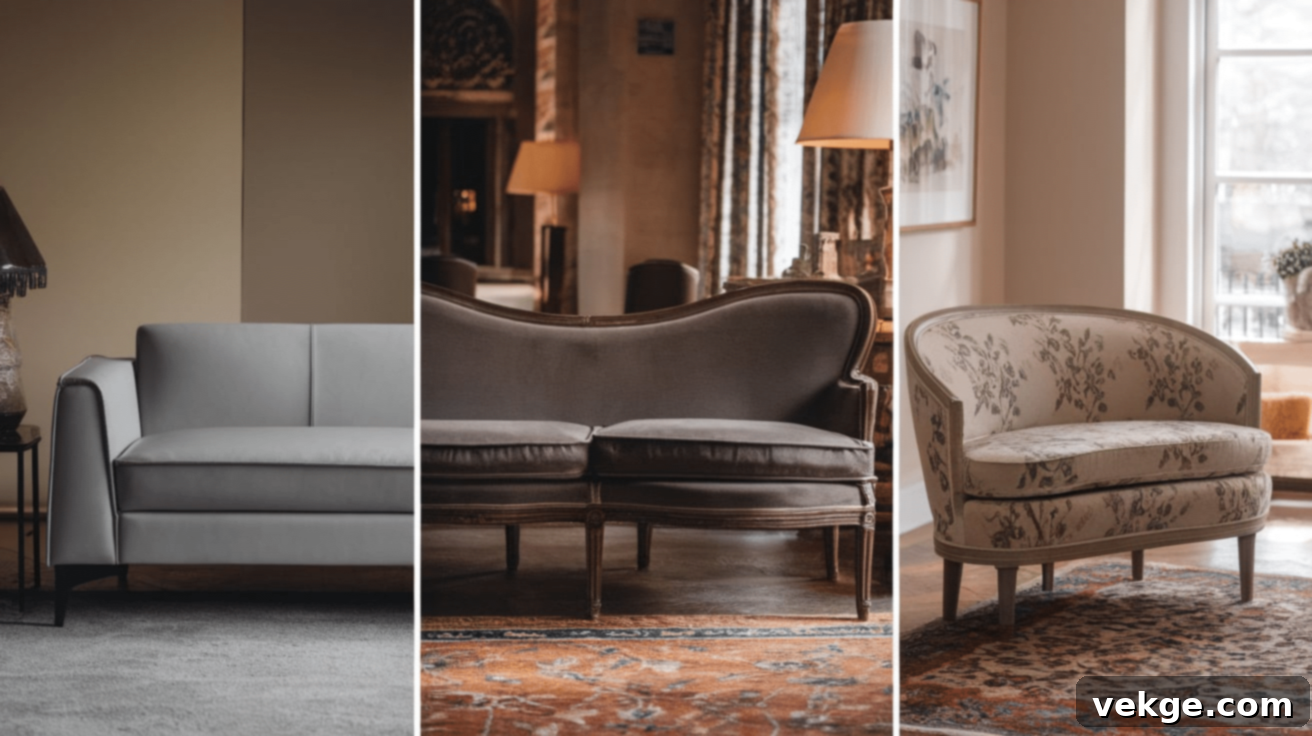
- Sofa: Sofas are often the primary style statement in a living room. Their size allows for more elaborate design details, from intricate tufting and bold patterns to distinct arm styles and leg designs. They come in an incredible range of aesthetics—from grand traditional to minimalist modern—making it easy to find a piece that defines or complements your chosen interior theme.
- Loveseat: Loveseats also come in diverse styles and designs, often mirroring those of larger sofas but scaled down. They can function as stylish accent pieces, adding a pop of color or texture without overwhelming the room. They are perfect for maintaining a cohesive look when paired with a matching sofa or for introducing a contrasting element to add visual interest to a smaller area.
6. Primary Function and Purpose
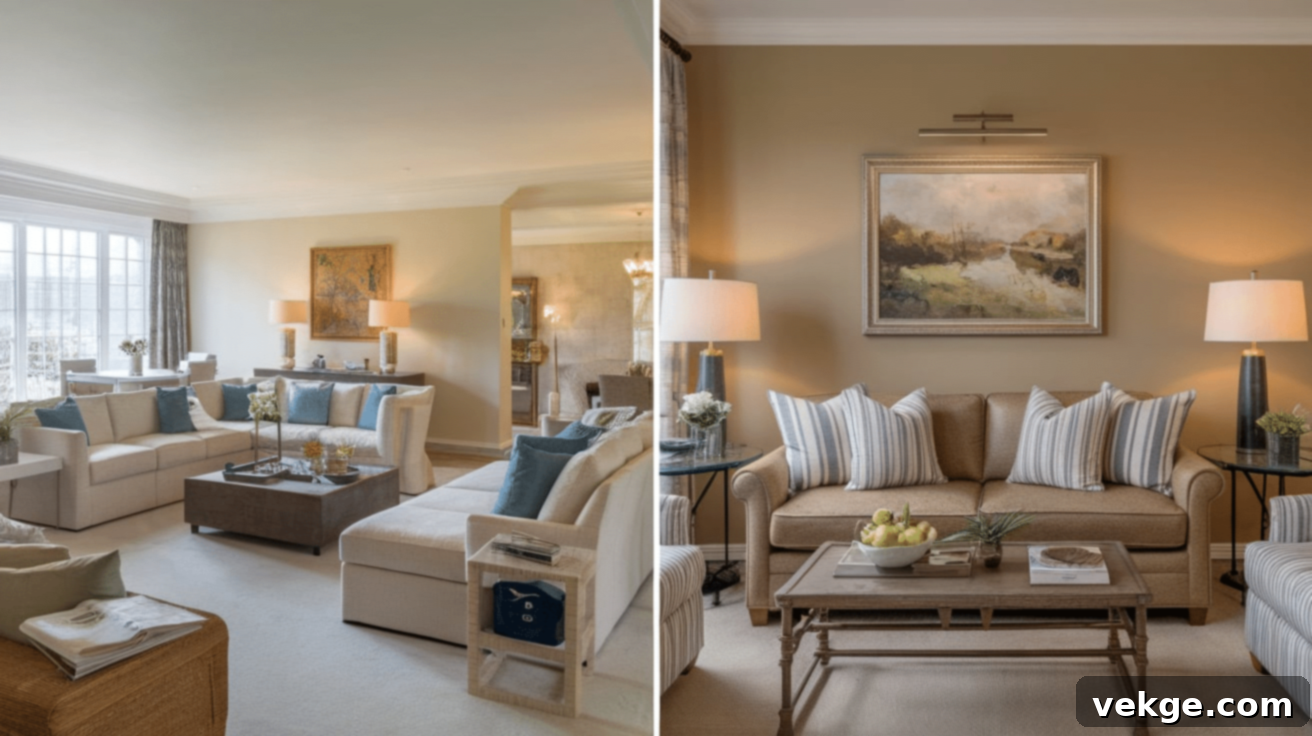
- Sofa: The primary function of a sofa is to serve as the main communal seating area in a home. It’s where families gather, friends socialize, and individuals relax extensively. Sofas are fundamental for creating an inviting atmosphere that encourages interaction and shared experiences, often dictating the flow and focal point of a social living space.
- Loveseat: Loveseats typically serve a more specific, often secondary, function. They are ideal for creating intimate seating zones, providing extra seating in conjunction with a larger sofa, or acting as the main seating in extremely compact spaces where a sofa is impractical. Their purpose leans more towards personal comfort and creating cozy, defined areas for two.
7. Versatility and Adaptability
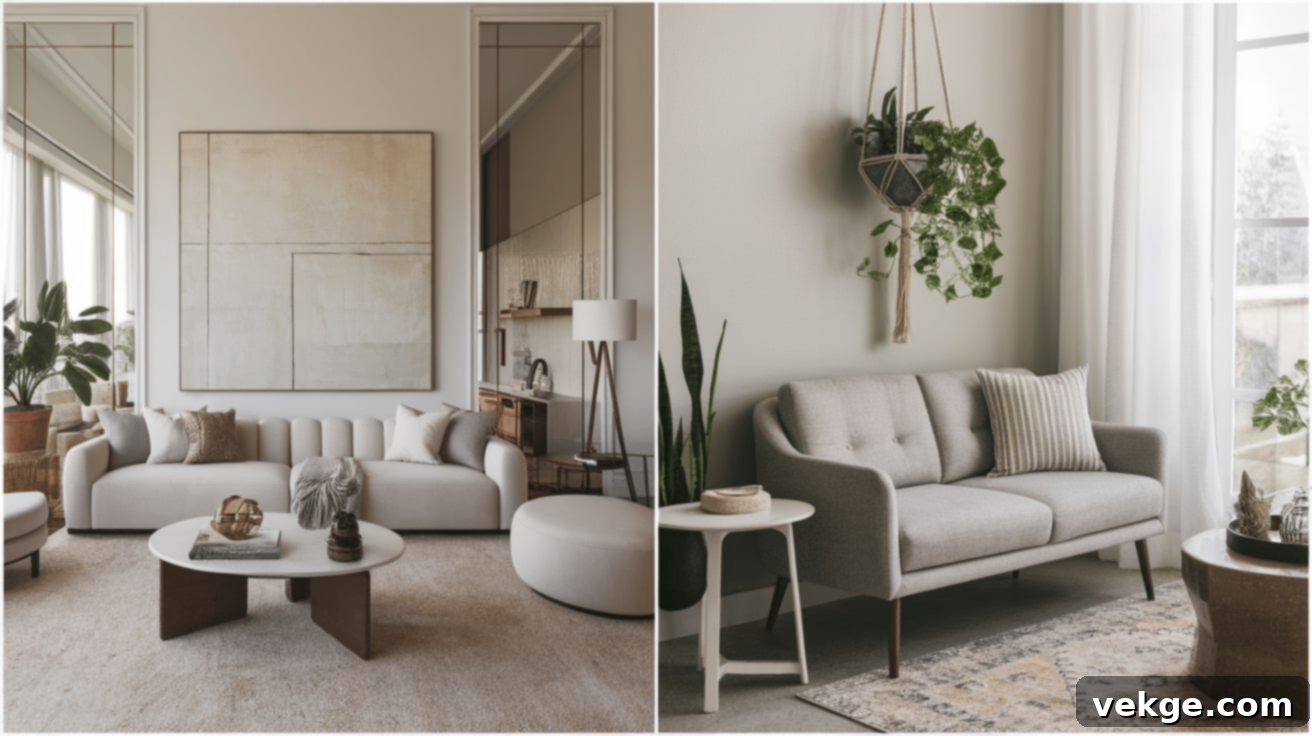
- Sofa: Sofas offer versatility in accommodating varying numbers of people, from a single lounger to a small crowd. They can anchor a room on their own or be combined with accent chairs, recliners, and other seating units to create a comprehensive and flexible seating arrangement. Their size allows them to adapt to diverse social scenarios.
- Loveseat: Loveseats are highly versatile in terms of placement and combination. They can fit into awkward corners, serve as a standalone piece in a small room, or work alongside a sofa, chaise, or armchairs to complete a varied seating ensemble. Their adaptability makes them excellent for creating distinct zones within a larger space or for furnishing unconventional room shapes.
Ultimately, the choice between a sofa and a loveseat hinges on a careful evaluation of your spatial constraints, your lifestyle, and your personal preferences for comfort and style. Each piece brings unique advantages to the table, designed to meet specific needs within the modern home.
Design & Budget: Styling Your Sofa or Loveseat
Beyond size and capacity, the design options and price points are critical factors when selecting between a sofa and a loveseat. These elements influence not only the aesthetic appeal of your space but also your overall budget.
Design Options for Sofas
- Variety of Styles: Sofas come in an unparalleled range of styles, from classic Chesterfield and elegant Tuxedo to contemporary Sectionals and functional Sofa Beds. You can find options with deep, plush cushions for ultimate comfort, sleek, minimalist lines for a modern aesthetic, or even modular designs that allow for flexible configurations. Features like built-in recliners, USB charging ports, and storage compartments are also common.
- Materials: The material choice for a sofa significantly impacts its look, feel, and durability. Popular choices include luxurious top-grain leather for a sophisticated and long-lasting finish, soft and inviting velvet for a touch of elegance, durable linen for a natural and breathable feel, and resilient synthetic fabrics like polyester or microfiber known for their easy maintenance. Each material offers distinct visual textures and tactile experiences.
Design Options for Loveseats
- Compact and Cozy Styles: While smaller, loveseats don’t lack in style. They often mirror the popular designs of sofas, available in modern, traditional, transitional, and even mid-century modern aesthetics. Their compact size makes them ideal for showcasing intricate details or bold colors without overwhelming a space. You’ll find options with tailored cushions, slender arms, and sometimes even innovative multi-functional features like pull-out beds for a compact guest solution.
- Fabric Choices: Similar to sofas, loveseats offer a wide array of fabric choices. Microfiber is a common choice for its stain resistance and durability, making it practical for high-traffic areas. Cotton and linen offer breathable, natural appeals, while performance fabrics provide enhanced longevity and easy care. The right fabric can transform a simple loveseat into a captivating accent piece.
Price Differences: Sofa vs. Loveseat
- Sofas: Generally, sofas represent a more significant investment. Their larger size, increased material usage, and often more complex construction contribute to a higher price point. Prices can range widely, from budget-friendly options starting around $300-$500 for basic models, up to $2,500-$5,000+ for high-end, custom, or designer pieces made with premium materials and advanced features. The brand, style, material, and any added functionalities all play a role in the final cost.
- Loveseats: As smaller pieces of furniture, loveseats are typically more affordable than full-sized sofas. Their prices usually range from around $200-$400 for entry-level models to $1,000-$2,000 for higher-quality or designer versions. This makes them an attractive option for those on a tighter budget, for furnishing smaller spaces, or for adding supplementary seating without a hefty financial commitment. However, specialized designs or premium materials can still elevate the price considerably.
When making your decision, consider not only your budget but also the long-term value. Investing in quality materials and construction for either a sofa or a loveseat can ensure greater durability and satisfaction over time. Always weigh the upfront cost against the desired lifespan and the specific role the furniture will play in your home.
Choosing the Right Seating: Which One Suits Your Space Best?
Selecting the ideal seating between a sofa and a loveseat is a personalized decision that should be guided by a clear understanding of your home’s unique characteristics and your lifestyle. Here’s a structured approach to help you decide:
1. Assess Your Room Size and Layout
- For Small Rooms or Limited Space: A loveseat is often the superior choice. Its compact dimensions prevent it from overwhelming the room, allowing for better traffic flow and a more open feel. Consider measuring your space carefully, including doorways, to ensure easy delivery and placement. A loveseat can provide comfortable seating for two without sacrificing precious square footage.
- For Larger Rooms or Open-Plan Living Areas: A sofa, particularly a generously sized one or a sectional, can effectively anchor a larger space. It fills the room without making it feel empty and offers ample seating for various activities. In open-concept layouts, a sofa can also help define distinct zones, such as a living area separate from a dining space.
2. Evaluate Your Seating Needs and Lifestyle
- If You Live Alone, as a Couple, or Have a Small Family: A loveseat might be perfectly adequate as your primary seating, providing cozy and intimate comfort. For minimal entertaining, it still offers enough space for a couple of guests. It’s ideal for a quiet, personal space.
- If You Have a Large Family, Frequently Entertain, or Prefer Ample Spreading Room: A sofa is almost certainly the better option. It accommodates more people comfortably, making it suitable for social gatherings, family movie nights, or simply providing individual space for everyone to relax without feeling cramped.
3. Prioritize Functionality and Desired Comfort Level
- For Lounging, Napping, or Stretching Out: A sofa is undoubtedly the champion. Its extended length and often deeper cushions are designed for ultimate relaxation. If sprawling out while watching TV, reading, or taking a quick nap is a priority, a sofa offers the necessary space and support.
- For Casual Sitting, Intimate Conversations, or Reading Nooks: A loveseat performs exceptionally well. It provides comfortable, upright seating for shorter periods or close interactions. It’s also excellent for creating a dedicated reading corner or a quiet spot for two within a larger room.
4. Complement Your Room’s Aesthetics and Existing Decor
- Sofas as a Focal Point: Due to their size, sofas naturally become a room’s focal point. Choose a style and color that either complements your existing decor or boldly defines a new aesthetic direction. A sofa’s design can significantly influence the overall ambiance of your living space.
- Loveseats as Accent Pieces or Complementary Seating: Loveseats can blend seamlessly into a design scheme, either by matching a larger sofa or by introducing a contrasting color or texture as an accent. They are perfect for adding visual interest and extra seating without overpowering the room’s primary design elements.
By thoughtfully considering these points, you can confidently determine whether a sofa, a loveseat, or perhaps a clever combination of both will best serve your home’s needs and aesthetic aspirations.
Maximizing Your Space: Combining Sofas and Loveseats
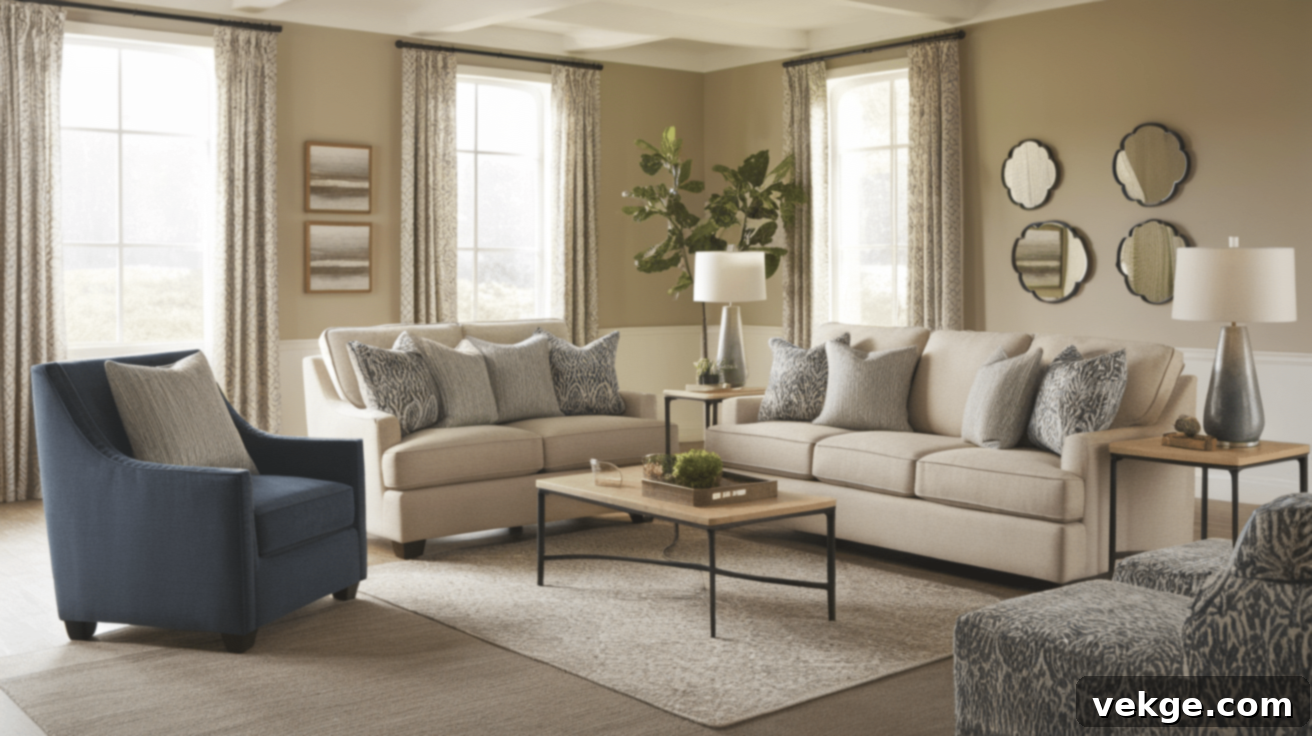
For those fortunate enough to have adequate space, combining a sofa and a loveseat is an excellent strategy to create a highly functional, versatile, and aesthetically pleasing seating arrangement in your living room. This approach allows you to harness the best of both worlds – the expansive comfort of a sofa and the intimate charm of a loveseat – to cater to diverse needs and social scenarios.
1. Balanced Seating for All Occasions: Utilizing both a sofa and a loveseat provides a comprehensive seating solution. You gain the capacity to comfortably seat a larger group for entertaining, while also having a dedicated, cozier spot for two. This balance ensures that your living area is adaptable, offering options for individual relaxation, intimate conversations, or lively group gatherings, all within the same space.
2. Create a Defined Conversation Area: One of the most effective ways to arrange a sofa and loveseat is to place them facing each other, or at a 90-degree angle to form an L-shape, ideally centered around a coffee table. This configuration naturally encourages conversation and interaction, creating an inviting and cohesive social zone. It defines the living area within an open-concept layout and makes the space feel more intentional and welcoming.
3. Mix and Match Styles for Dynamic Decor: You don’t necessarily have to buy a matching set. Mixing different styles, colors, or even materials for your sofa and loveseat can add significant character and depth to your room. For instance, a contemporary sofa paired with a traditional, upholstered loveseat can create a compelling visual contrast. Just ensure there’s a unifying element, like a shared color palette or a complementary design theme, to maintain harmony.
4. Play with Room Layouts: The arrangement possibilities are numerous. In a large room, place the sofa along the longest wall and the loveseat perpendicular to it, forming an L-shape. Alternatively, position them opposite each other with an accent chair at one or both ends to complete a U-shaped arrangement. For long, narrow rooms, placing the loveseat at one end of the sofa can extend the visual length while maximizing seating.
5. Harmonize with Accessories: To tie the entire look together, leverage accessories such as throw pillows, blankets, and area rugs. Choose pillows that feature colors or patterns found on both the sofa and loveseat, or select a large area rug that grounds both pieces within the same space. This helps blend different furniture styles and creates a cohesive, polished look. Matching side tables or lamps can also reinforce unity.
Combining a sofa and a loveseat is a superb way to maximize seating capacity, enhance functional versatility, and elevate the stylistic appeal of your living area. By carefully considering your room’s dimensions, selecting complementary pieces, and experimenting with thoughtful layouts, you can craft a sophisticated, comfortable, and inviting home environment that perfectly caters to all your needs.
Conclusion: Making Your Informed Furniture Choice
Navigating the choice between a sofa and a loveseat, or even deciding to incorporate both, ultimately boils down to a thoughtful assessment of your specific space, lifestyle requirements, and personal aesthetic preferences. Each piece of furniture brings its own set of advantages designed to enhance comfort and functionality within your home.
Sofas, with their generous dimensions and expansive seating capacity, are the undisputed champions for larger living rooms, family homes, and frequent entertainers. They provide ample space for lounging, gathering, and creating a central hub for social interaction. Their vast array of styles, materials, and features ensures there’s a sofa to perfectly match any decor and comfort level, making them a versatile and enduring investment for most households.
Conversely, loveseats offer a smart and stylish solution for compact areas, intimate settings, or as a complementary piece of additional seating. Their smaller footprint is invaluable for apartments, studios, or defining cozy nooks, without compromising on comfort or design. Loveseats are typically more budget-friendly and excel at providing a snug, personal space for two, making them an ideal choice where space is at a premium or specific seating arrangements are desired.
The best choice for your home is the one that aligns most closely with your practical needs and aesthetic vision. If your priority is extensive seating for many, and you have the room to accommodate it, a sofa is the clear winner. However, if you’re working with limited space, desire an intimate spot for two, or wish to create a balanced seating arrangement by pairing it with a larger sofa, then a loveseat becomes an indispensable and highly functional option. Both promise to infuse your home with comfort, style, and a welcoming ambiance, tailored to your unique way of living.
Frequently Asked Questions (FAQs)
Which one is more affordable, a sofa or a loveseat?
Generally, loveseats are more affordable than sofas because they require less material and have a smaller construction. While prices for both vary widely based on style, material quality, brand, and added features, a loveseat typically represents a lower initial investment.
How do I know if I need a sofa or a loveseat?
Consider your room size and seating needs. If you have a spacious room and need to seat three or more people regularly (family, guests), a sofa is the better choice. If your room is small, or you primarily need seating for just one or two individuals, a loveseat will be a perfect, space-saving fit.
Which is better for lounging, a sofa or a loveseat?
Sofas are generally superior for lounging. Their greater length and depth provide ample space to stretch out, lie down, or comfortably recline. If you prioritize relaxing, napping, or sprawling out while watching TV, a sofa offers significantly more room and comfort compared to a loveseat.
Can a loveseat work as the main seating in a room?
Yes, absolutely. A loveseat can effectively serve as the main seating in smaller rooms, such as studio apartments, dens, or compact living areas where a full-sized sofa would be too large. It’s an excellent choice for creating a cozy, functional space for one or two people.
How long do sofas and loveseats typically last?
The lifespan of both sofas and loveseats can vary significantly, usually ranging from 7 to 15 years. This depends heavily on the quality of construction, the durability of the materials used, how frequently the furniture is used, and the level of care and maintenance it receives. Higher-quality pieces tend to last longer.
Can I combine a sofa and a loveseat in the same room?
Yes, combining a sofa and a loveseat is a very popular and effective design strategy, especially in larger living rooms. It allows you to maximize seating capacity, create a balanced look, and define distinct conversation areas. Ensure there’s enough space for both pieces to fit comfortably without cluttering the room.
